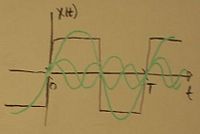Class Notes 1-5-2010: Difference between revisions
Jump to navigation
Jump to search
Brian.Roath (talk | contribs) |
Brian.Roath (talk | contribs) |
||
| Line 24: | Line 24: | ||
==Example== |
==Example== |
||
[[Image:January_5_graph_2.jpg|200px|thumb|left|Function waves with varying periods based on the function x(t) = x(t+T)]] |
[[Image:January_5_graph_2.jpg|200px|thumb|left|Function waves with varying periods based on the function x(t) = x(t+T)]] |
||
Given function: |
Given function: |
||
:<math> x(t) = x(t+T) \,</math> |
|||
:<math> x(t) = \sum^\infty_{n=1} \left[ b_n \sin \left( \left( \frac {2\pi n} {T} \right) t \right) \right] </math> |
:<math> x(t) = \sum^\infty_{n=1} \left[ b_n \sin \left( \left( \frac {2\pi n} {T} \right) t \right) \right] </math> |
||
1) Use vector analogy |
1) Use vector analogy |
||
Revision as of 16:19, 17 January 2010
This article covers the notes given in class on January 5, 2010.
Subjects Covered
1) Linear Systems
2) Functions as Vectors
Example
Given function:
1) Use vector analogy
External Links
- [Class Notes.].
Authors
Colby Fullerton
Brian Roath













![{\displaystyle x(t)=\sum _{n=1}^{\infty }\left[b_{n}\sin \left(\left({\frac {2\pi n}{T}}\right)t\right)\right]}](https://wikimedia.org/api/rest_v1/media/math/render/svg/1b15fa18143738e6bbe3d2aefb2cc8a5ac979bb7)
![{\displaystyle x(t)\cdot \sin \left({\frac {2\pi mt}{T}}\right)=\sum _{n=1}^{\infty }\left[b_{n}\sin \left(\left({\frac {2\pi n}{T}}\right)t\right)\cdot \sin \left({\frac {2\pi mt}{T}}\right)\right]}](https://wikimedia.org/api/rest_v1/media/math/render/svg/570a428f69ebcdd14e9a313bceea1472ddbf5f67)
